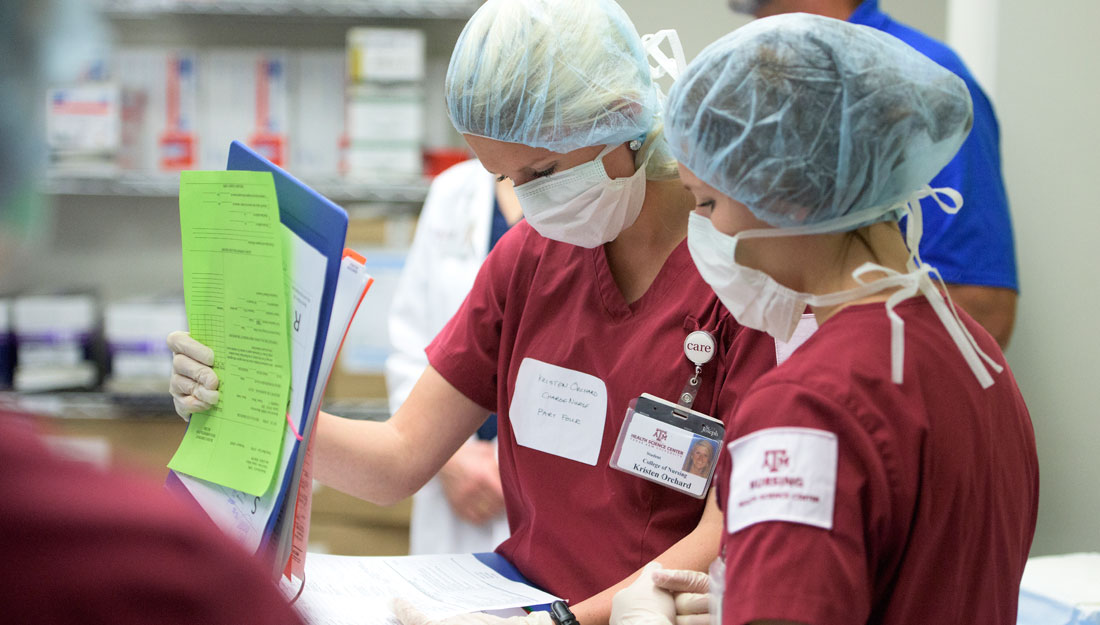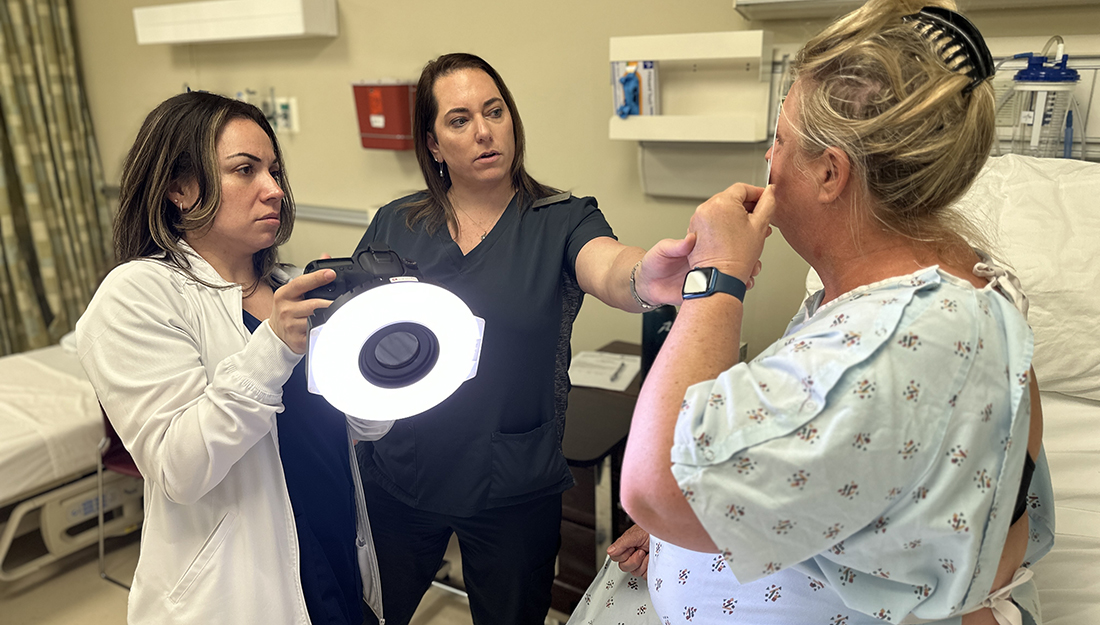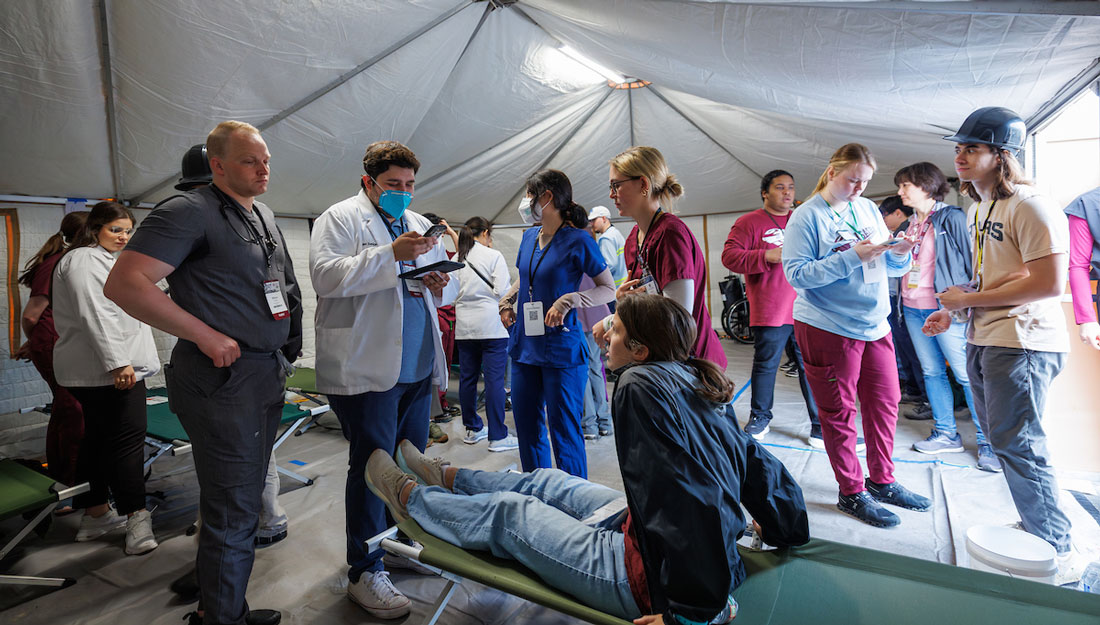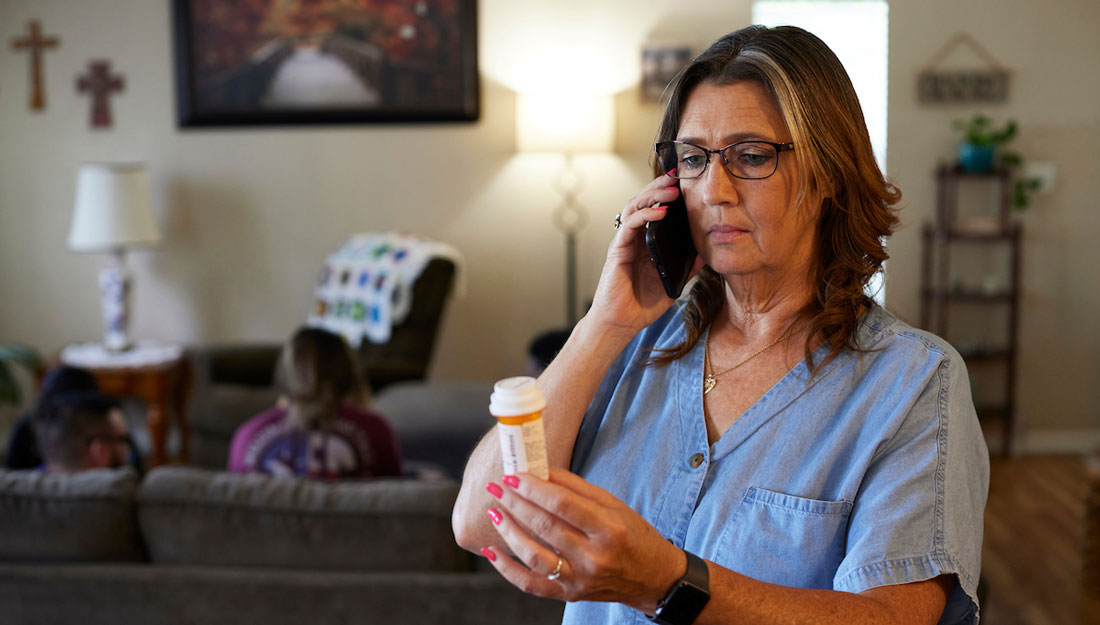Health teams of the future: A look inside the simulation center

The physician stands at the foot of the bed helping to deliver a baby. The child’s father sits at the head of the bed, encouraging the mother to “push, just a little more, Mallory, honey.”
It’s a scene that plays out at thousands of hospitals across the country every day, but this is different. The “physician” is actually a medical student, the “father” is an actor, and the “mother,” Mallory, is a realistic teaching manikin that can actually “give birth.” She is voiced by another actor, or as they are called here, a standardized patient.
This is just one of many scenarios conducted at the Texas A&M Health Science Center’s Clinical Learning Resource Center, a 27,000-square-foot, realistic hospital setting equipped with the latest tools and technology to enhance learning.
Although the medical student is being coached through the whole process by a College of Medicine obstetrics and gynecology assistant professor, William Price, M.D., this simulation is teaching far more than obstetric techniques. Also in the room are three nursing students, and they are all working together to take care of the patient.
“I was having to give orders for care that the patient needed, and I knew my team was relying on me if anything went wrong,” said Jacob Hammond, a third-year medical student.
Medical schools around the country have been increasing focus on collaboration between different disciplines of health-related fields, a practice called inter-professional education (IPE).
“Through the IPE simulation, I was able to see the importance of communication with other health care providers,” said nursing student Shannon Braugh. “Rather than simply being told the importance of working with the rest of the health care team, we got to put it in action. I feel that I will be able to apply this communication better in the future with ‘real’ patients by having the opportunity to practice it in this setting.”
The student physician delivers a healthy manikin named Justin, but Mallory is losing a good deal of blood. The nurses and physicians utilize their educational training to jump into action, providing drugs and other techniques to get it under control.
“The simulation was a great way to see practically what we’ve learned in the classroom,” Braugh said. “While we have received lectures about what to do in that situation, it came to life, much more, to be acting as a nurse in the simulation.”
Just as they would in a “real” hospital setting, the four medical students and 13 nursing students participating in this scenario switch off, only here they change every few minutes, instead of every few hours like they would taking care of a real patient. Those not actively involved at any given point are working on the code and rapid response teams, ready to step in if their colleagues call.
Right after the first handoff to a new medical team, the scenario moved from labor and delivery to a hospital room. Here, a standardized patient has replaced the manikin, and for a few minutes, everything is calm as the nurses check her vital signs. When the physician comes in, he orders a blood transfusion to help replace some of the volume lost during delivery, but—just as family members often are—her husband is nervous about it. The physician and nurses have a chance to practice their communication skills as they assure him that the blood has been tested for common pathogens and is safe, and what’s more, Mallory really needs it.
Mallory just keeps complaining that she’s tired.
“I had to make sure the patient had given consent for the treatment we were providing,” Hammond said. “By doing this, I learned how I can assess mental status to determine if a patient is capable of making proper decisions regarding their treatment.”
When the teams switch again, the new nurses examine Mallory and find that she has been bleeding more. As coached by the faculty members in the control room via an earpiece, the husband starts to panic. “That’s a massive amount of blood!” he says. “How can she be losing that much blood?”
“In the moment, I often forget that the situation isn’t ‘real’ because the situation that we are acting out could be real on so many levels,” said Patty de Veyra, a nursing student in the class of ’16. “I tried to ‘act’ the way I hope I would carry myself, if the situation were to present itself in real life.”
The nurses call in the physician for help, and when soon after Mallory loses consciousness, they decide to prepare her for emergency surgery. Mallory’s husband—still holding the manikin baby, Justin, refuses to leave his wife’s side as the nursing students try to persuade him to move aside so they can tend to their patient.
“I believe it’s important to take the opportunity to be engaged with your patients,” de Veyra said. “After this simulation, I’ve learned that the simplicity of acknowledging and listening to your patient goes a long way. Patients want to be heard. They need to be heard, and I definitely learned that I will try my hardest to not only communicate with the other health care providers, but to also be an advocate for my patients.”
Finally, the nurses connect with Mallory’s husband and sit him down in a chair while the others wheel her off to surgery.
“It is my hope that the nursing students find their voices and start developing into the role of patient advocate,” said Shelley White-Corey, RNC, WHNP, a clinical assistant professor in the College of Nursing and one of the organizers of the exercise. “I want to see them develop a sense of confidence to be proactive in their communication with other health care providers, and also in the care of their patients.”
The final part of the scenario takes place in the operating room, with a nurse doing CPR on the manikin and the physicians gowned and ready for surgery. In this scene, the faculty members—Price, White-Corey and nursing professor Elizabeth Wells-Beede—are more involved; they’re in the room coaching them. At last, the scenario is over, the patient is “saved” and everyone gathers back in one room for the debriefing.
“I enjoyed working with the medical students,” de Veyra said. “The simulation gave us the opportunity to practice what collaborative care feels like.”
The faculty members have been recording the simulation and bookmarking ideas they want to discuss with the group, both things the students could do better or things that went especially well.
“I’ve learned that every moment is filled with opportunity, and it’s what I do with those opportunities that define the outcome of my actions,” de Veyra added. “There was no barrier between the two professions, and they definitely made the team stronger.”
“Our focus is on teamwork, collaboration, and communication,” White-Corey said. “What I hope the students come away with is a sense of ‘team’ and a greater understanding about how our roles work together.”
Media contact: media@tamu.edu


